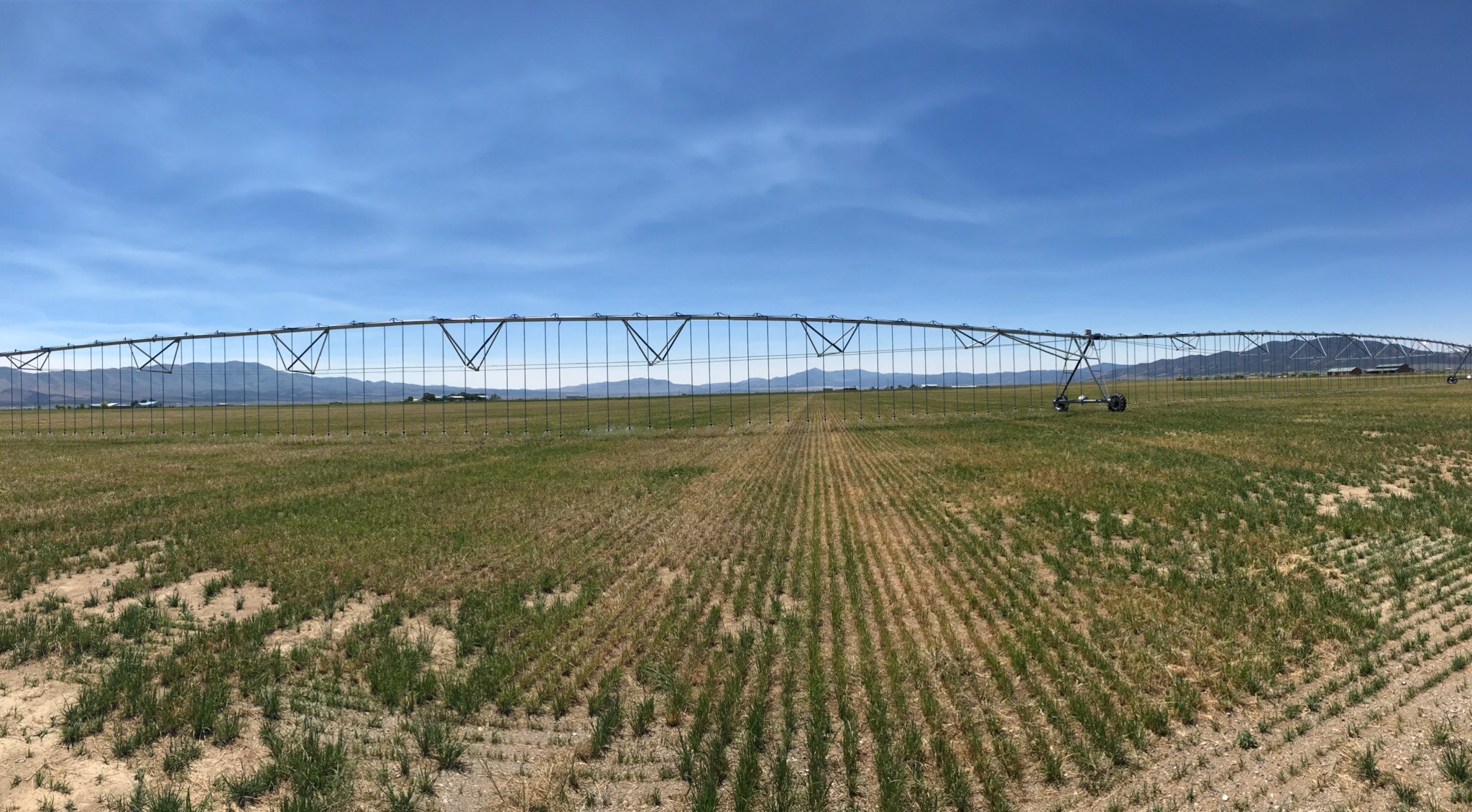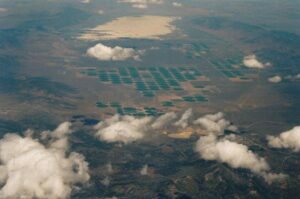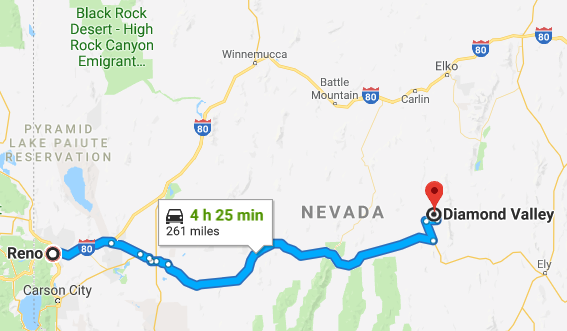Departing state engineer approves controversial water market near Eureka

In the valley north of the central Nevada town of Eureka, dozens of circle irrigation systems spray water onto alfalfa each spring. The water that flows through the rotating center pivots comes from the ground. But that limited groundwater supply is being overpumped and beginning to dry up at a rate that has long concerned Nevada’s top water regulator, the state engineer.
Each year, water users near Eureka pump more than twice the amount of groundwater from Diamond Valley — a hub for hay growers in central Nevada — than is replenished by Mother Nature. Underneath the valley, the water table has dropped further away from the surface.

The result: ranchers and farmers, like Vickie Buchanan — who has a priority, or senior, claim to water — have been forced to extend their wells to reach the water they have a right to use.
“I’m completely senior, but I’ve spent a fortune trying to build new wells,” Buchanan said.
Last week, the state approved a first-of-its-kind plan to reduce water use in Diamond Valley, a community caught between a desire to maintain its agricultural industry and the realities of water availability in the high desert. The plan revolves around the concept of a water market. But it also deviates from Western water law — and will almost certainly be challenged in court.
If the groundwater plan does not go into effect by 2025, the state could be forced to halt more than half the valley’s pumping in one blunt move, with economic consequences rippling across a basin that is said to bring in about $22 million from producing over 110,000 tons of hay annually. Some junior water users said in public comments that they would have to declare bankruptcy.
Under the plan, each water user would get a certain number of shares — based on a formula — that they could freely sell, trade or bank. Each share would represent a unit of water. And each year, those units would decrease in amount, resulting in an overall reduction in pumping.
Former State Engineer Jason King approved the plan on Jan. 11, one of his last actions before he retired, noting that the years of local debate over the plan had been “emotional and difficult.”
Irrigators have been working on a groundwater management plan in Diamond Valley for more than five years. The market emerged after lawmakers passed a bill in 2011 allowing water users to create a local plan to reduce pumping, if approved by a majority of irrigators. Lawmakers kept the guidelines for the plans vague, which gave discretion to the state engineer and flexibility to local water users interested in thinking beyond the strict application of Western water law.
Their motivation was simple.
Across the West, the law is set up to protect senior rights, water users with the earliest claims to divert water. In times of scarcity, those with senior rights are entitled to their full allocation before newer diverters with junior rights. State regulators are required to curtail junior rights if their pumping prevents diverters with senior rights from accessing their water.
Without a plan in place by 2025, a curtailment action remains imminent.
“The irrigators that support this plan understand that we all need to sacrifice for the long-term benefit of the community and the long-term continued success of the farming industry,” one irrigator wrote in public comment, according to the order, which cited the statement.
Proponents argue that, by turning rights into shares, a water market will give water users more flexibility to reduce their pumping. A market would soften the blow of curtailment by easing the basin into a world in which irrigators use less water. It would allow farmers to use a portion of their claim and lease the rest of it without being punished by traditional Western water law.

Irrigators could, for instance, lease shares and get compensated to fallow a field without losing the property value of their water right. In another instance, an irrigator could switch to a less water-intensive crop than hay and then lease or sell the water that they conserved. The plan would also allow irrigators to bank and store unused shares of groundwater for future use.
“[It] is meant to provide some certainty,” said Jake Tibbitts, Eureka County’s natural resource manager. “There’s no perfect solution. We don’t know what that perfect solution would be.”
But opponents say the plan deviates too far from the tenets of Western water law and will harm farmers with senior claims. Even supporters of the water market believe that senior users are likely to appeal the plan in District Court. Irrigators have until early February to file an appeal.
In strict curtailment actions, senior water users would not lose a drop of water until all junior users lost their allocations. The plan deviates from that by reducing water use for both senior and junior users in Diamond Valley (though junior users will see reductions at a faster rate).
Citing a New Mexico court case, the state engineer argued in his order that the market complied with current water law by reducing junior rights faster than senior rights. Once the water market is set up, irrigators with senior rights will receive more shares than those with junior rights.
Paul Taggart, a water lawyer who is representing a client with historical claims to Diamond Valley springs, said the plan was insufficient because it did not include all users. Taggart also questioned whether the reductions in use were sufficient to end the over-pumping issue.
“What’s really critical is that it does not fix the harm that has been done to senior water rights and allows [the problem] to continue for decades — even forever,” Taggart said in an interview.
State regulators estimate valley pumping totals at about 76,000 acre-feet (an acre-foot is the unit that describes how much water can fill one acre to a depth of one foot). Hydrologists estimate that the amount of water that can be pumped sustainably is about 30,000 acre-feet. The plan, however, may only reduce water use to about 34,000 acre-feet over two to five decades.
As a result, some worry that the plan could continue to leave the door open for over-pumping to continue. Although the plan applies to irrigation, mining and milling, it excludes municipal groundwater users and domestic wells from taking reductions in their water use.
In his order, the state engineer defended the plan’s exemptions, noting that 96 percent of the basin’s water users will be represented in the water market. He also noted that the estimate for sustainable pumping could fluctuate — some believe it is 35,000 acre-feet — and that the rate of reductions could be adjusted as water users see how the groundwater aquifer responds.
But water users with senior rights are divided. And one nuance is that 90 percent of the irrigators have a combination of junior and senior rights. When the plan went up for a vote in July, owners of about 47 percent of the senior rights permits supported the plan. A majority of water users across the basin approved of the plan by more than 50 percent, the requirement by statute.
Even with the approval, other issues are at play that could affect the market’s implementation.
For years, Taggart’s firm has been locked in litigation with Eureka County and the state engineer over Sadler Ranch. Developed in the late 1800s by Nevada’s ninth governor, Reinhold Sadler, the ranch has what are known as “vested rights,” rights to water that predate Nevada water law. Users with vested rights have priority above all other water users, even senior water users.
At least four decades of over-pumping in Diamond Valley has dried up springs that Sadler Ranch claims to have historical vested rights to use. As of early 2017, the ranch had been asking for 7,500 acre-feet of water to mitigate what had been lost to over-pumping. The state offered the ranch about 975 acre-feet of mitigation water. But the question of how much water they are entitled to became the subject of litigation. A judge said the ranch was entitled to about 5,000 acre-feet of water, though that number could change in an ongoing procedural process.
Sadler Ranch also sued to curtail pumping in the basin, litigation that is pending. The outcome of that litigation could end up affecting a groundwater plan meant to avoid such action.
The state has never quantified all of the vested claims to water rights in Diamond Valley. As a result, the state is undergoing a lengthy adjudication to determine what water users are entitled to what claims based on their historical use of the water. That process, which has to be certified by a court and could affect the plan, might take another five years — or even longer.
Despite the hurdles, the concept of a water market in Diamond Valley has attracted national attention as a way to tackle the challenges that plague groundwater basins across the West.
“It’s the first of its kind,” said Debbie Leonard, a McDonald Carano lawyer representing junior users in the adjudication. “There were a lot of people waiting to see what happened with this.”
In many aquifers throughout the West, there is more water on paper than there is actual water to go around. The difference between “paper water” and “wet water” is often the result of blithe predictions by past policymakers that there was more water to go around. It is also the result of federal policies, like the Desert Land Entry Act and the Homestead Act, which encouraged Western development on public lands but often ignored the arid realities of the region.
Buchanan said the market, if successful, could serve as a model for the region, especially for agricultural communities that are using groundwater at unsustainable rates but don’t want to see the vast majority of their junior irrigators go out and declare bankruptcy because of a curtailment call.
“We know that it's never going to bring the water [rights] back,” she said. “But hopefully it will make it be sustainable — and we won't just keep pumping ourselves dry.”
